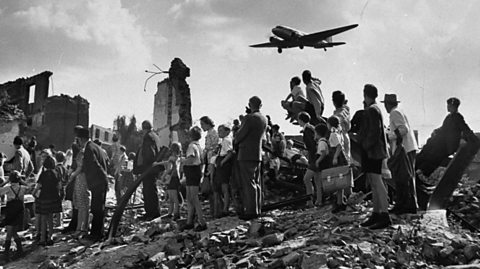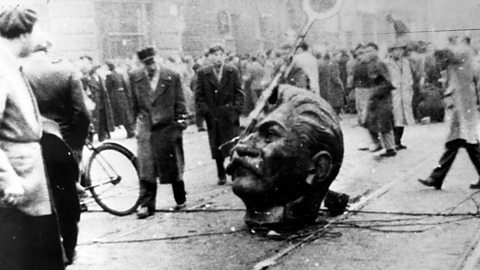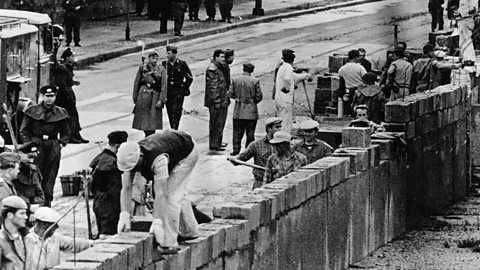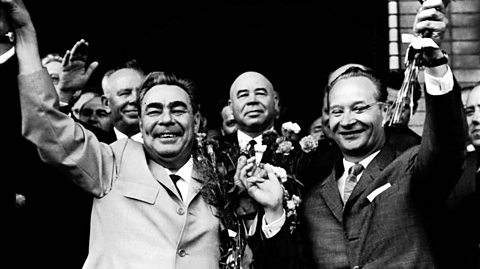The Soviet takeover of Eastern Europe

As the Allied forces moved in from the West to secure a German defeat in World War Two, the Soviet forces moved into Germany from the East, replacing Nazi forces in a number of countries in Eastern Europe.
The Americans and the British could do nothing about this while Nazi Germany remained undefeated.
After all, the USSR was an ally at this time.
However, it was clear that Stalin was very reluctant to give up control of Eastern Europe, which he saw as a Soviet sphere of influenceIn international politics, an area in which one nation holds, or claims to hold, dominant power over a country or several countries..
Question
What is a Soviet sphere of influence?
The Soviets installed governments in a group of countries around themselves for protection and exploitation - a number of Eastern European states were controlled by the Soviets and were sympathetic to the USSR.
Actions of the USSR in Eastern Europe, 1945â49
Despite the promises made by Stalin at the Yalta ConferenceA meeting of Churchill, Stalin and Roosevelt in 1945, where they planned the warâs end, the division of Germany into occupation zones and how post-war Europe should be organised. to allow free elections, he had in fact started turning Eastern Europe into a buffer zoneAn area giving someone protection against a threat, eg the USSR wanted a buffer zone around them after being invaded by Germany in both World Wars. between the USSR and Western Europe.
Stalin feared that Eastern Europe could be the doorway for an attack on the USSR by the West.
During 1946â47, Stalin made sure that communistSomeone who believes in the political ideology of communism, a system of running a country in which all means of production such as tools, factories and raw materials, are owned by the community as a whole. Private property does not exist and each individual contributes according to their ability and receives according to their needs. This means there is no hierarchy of social class. governments came to power in all the countries of Eastern Europe (the countries which the USSR had conquered in 1945).
Timeline: Soviet takeover of Eastern Europe
| Country | Year | Methods used |
|---|---|---|
| Albania | 1945 | A communistSomeone who believes in the political ideology of communism, a system of running a country in which all means of production such as tools, factories and raw materials, are owned by the community as a whole. Private property does not exist and each individual contributes according to their ability and receives according to their needs. This means there is no hierarchy of social class. government took power at the end of World War Two. |
| East Germany | 1945 | East Germany was part of the Soviet zone of occupation as agreed at the Yalta ConferenceA meeting of Churchill, Stalin and Roosevelt in 1945, where they planned the warâs end, the division of Germany into occupation zones and how post-war Europe should be organised. and in 1945 the Soviets set up a communist regime there. |
| Romania | 1945 | In the 1945 elections, a communist-led coalition government was elected. The communists gradually removed their coalition partners. |
| Bulgaria | 1946 | In 1946 the Bulgarian monarchy was abolished. Later that year, a communist government was elected. |
| Poland | 1947 | In 1947, Stalin invited 16 non-communist politicians to Moscow, where they were arrested. With their political opponents removed, the Polish communists won the election. |
| Hungary | 1948 | Stalin allowed elections, in which the non-communists won a big majority. However, communist politician, Rakosi, hinted that the Russians would take over if need be. Then he got control of the police, and started to arrest his opponents. He set up a brutal secret police unit, the AVO. By 1947, Rakosi had complete control. The gradual takeover by the communists was completed on 18 August 1949, when Hungary became the People's Republic of Hungary. |
| Czechoslovakia | 1948 | At elections in 1948, only communists were allowed to stand and a communist government was elected. |
The response of the USA and its allies
For the Western Allies, the setting up of communistSomeone who believes in the political ideology of communism, a system of running a country in which all means of production such as tools, factories and raw materials, are owned by the community as a whole. Private property does not exist and each individual contributes according to their ability and receives according to their needs. This means there is no hierarchy of social class. governments in Eastern Europe was a major concern.
Now it seemed that in many countries the hard-won freedom from Nazi dictatorship A country ruled by someone who has complete authority. was being replaced by communist dictatorships.
The Long Telegram
In 1946, George Kennan, an official at the US Embassy in Moscow, was asked to provide a summary of what the Soviets were up to and their intentions in Eastern Europe.
°±đČÔČÔČčČÔâs response became known as The Long Telegram because it was 8,000 words in length.
°±đČÔČÔČčČÔâs telegramA communication system where messages were electronically transmitted over distance through wires and then printed out at the destination and delivered by hand. outlined a number of points:
- The USSR was heavily armed and feared the outside world.
- The USSR was determined to spread communismA system of running a country in which all means of production such as tools, factories and raw materials, are owned by the community as a whole. Private property does not exist and each individual contributes according to their ability and receives according to their needs. This means there is no hierarchy of social class. and therefore there could be no peaceful co-existence between the USSR and the USA.
- The USA was stronger than the USSR and so communism could be âcŽÇČÔłÙČčŸ±ČÔ±đ»ćâ.
The emergence of the Cold War and the impact on relations, 1946â47
By 1946, the scene was set for the Cold War in Europe:
- The USSR would attempt to dominate Eastern Europe and spread communismA system of running a country in which all means of production such as tools, factories and raw materials, are owned by the community as a whole. Private property does not exist and each individual contributes according to their ability and receives according to their needs. This means there is no hierarchy of social class. where possible. They felt this was necessary for their security.
- The USA would commit to a policy of containmentAn American policy to try and stop communism from spreading to other countries., which meant stopping the spread of communism into Western Europe.
The Iron Curtain speech
On 5 March 1946, in a speech at Fulton in the USA, the former British Prime Minister, Winston Churchill, condemned the Soviet expansion in Eastern Europe in his famous Iron Curtain speech.
âŠfrom Stettin in the Baltic to Trieste in the Adriatic, an iron curtain has descended across the continent.
â Winston Churchill, 5 March 1946
In a nutshell, what Churchill meant by this was that the Allies had spent six years fighting for the freedom from fascism in Europe, only to have half the continent now under Soviet dictatorship A country ruled by someone who has complete authority..
Whilst there was no real physical barrier, there was a clear division between the democratic states of the West and the communistSomeone who believes in the political ideology of communism, a system of running a country in which all means of production such as tools, factories and raw materials, are owned by the community as a whole. Private property does not exist and each individual contributes according to their ability and receives according to their needs. This means there is no hierarchy of social class.states of the East.
Many in the West were concerned that Stalin would not stop in Eastern Europe but would expand his empire further West.
The Truman Doctrine
President Truman was very concerned by the growth of Soviet power.
If the spread of communismA system of running a country in which all means of production such as tools, factories and raw materials, are owned by the community as a whole. Private property does not exist and each individual contributes according to their ability and receives according to their needs. This means there is no hierarchy of social class. was to be halted, Truman believed that the USA would have to be much more active in world affairs.
This policy became known as Truman DoctrineEstablished in 1947 by President Harry S Truman, this policy provided US military and financial aid to countries that were at risk of being taken over by communists..
- 1946 - civil war in Greece between its western-backed government and pro-communist forces.
- March 1947 - Truman gives a speech to Congress asking for money to support Greece's fight against communism. He also refers to the USA's duty to stand up for any 'free people' who are under threat.
- America was now committed to a policy of containment, or stopping the spread of communism.
- Truman was referring to countries resisting an armed communist takeover and this gave the US government opportunity to take action where they felt they needed to step in.
I believe it must be the policy of the United States to support free people who are resisting attempted control by⊠outside pressures⊠The free peoples of the world look to us for support in maintaining those freedoms.
March 1947
Question
What is containment?
The USAâs policy to stop communismA system of running a country in which all means of production such as tools, factories and raw materials, are owned by the community as a whole. Private property does not exist and each individual contributes according to their ability and receives according to their needs. This means there is no hierarchy of social class.from spreading any further in Europe.
Question
Sample question: What does Source A tell us about George °±đČÔČÔČčČÔâs recommendations to the USA government?
In these circumstances it is clear that the main element of any United States policy toward the Soviet Union must be that of long-term, patient but firm and vigilant containment of Russian expansive tendencies.
American diplomat, July 1947)
- US policy towards the USSR must not be short term and quick to react but rather a longer term approach is needed.
- That the USSR are attempting to spread communism further as he states âRussian expansive tendencies.â
Marshall Aid
Some Western European countries had enormous debts, extreme poverty and social problems after World War Two which meant support for communistSomeone who believes in the political ideology of communism, a system of running a country in which all means of production such as tools, factories and raw materials, are owned by the community as a whole. Private property does not exist and each individual contributes according to their ability and receives according to their needs. This means there is no hierarchy of social class.parties was strong.
The USA reasoned that the better off a country was, the less likely it would be to turn to communism.
It also meant that European countries would be more able to trade with the USA.
In 1947, President Truman sent General George Marshall to see what could be done to reduce popular support for communism.
This Marshall Aid would be spent to help the economies of Western Europe recover after World War Two and make them less likely to be won over by communism.
Marshall Aid went hand in hand with the Truman DoctrineEstablished in 1947 by President Harry S Truman, this policy provided US military and financial aid to countries that were at risk of being taken over by communists. - both of which made up the USAâs containmentAn American policy to try and stop communism from spreading to other countries. policy.
How did the USSR react to Marshall Aid?
- It declared Marshall AidFinancial assistance given by the USA to European countries in 1948 to help them rebuild after World War Two and to stop the spread of communism. to be âdollar imperialismâ and claimed the USA was throwing its economic weight around, using it to gain influence in Europe.
- It stopped the Eastern bloc countries under its control from applying for it.
- It set up Cominform â the Communist Information Bureau â an organisation which had as its aim to tighten Soviet control in Eastern Europe, to build heavy industry there and to create a trade network between communistSomeone who believes in the political ideology of communism, a system of running a country in which all means of production such as tools, factories and raw materials, are owned by the community as a whole. Private property does not exist and each individual contributes according to their ability and receives according to their needs. This means there is no hierarchy of social class. countries.
- It also established Comecon â the Council of Mutual Economic Assistance â to administer its own plan of financial aid to keep the Eastern blocCountries in Eastern Europe that were controlled by the Soviet Union, for example Poland, Hungary and Czechoslovakia. countries happy.
The impact of Marshall Aid
By 1952, most Western European countries had recovered to their pre-war levels of production.
Marshall AidFinancial assistance given by the USA to European countries in 1948 to help them rebuild after World War Two and to stop the spread of communism. had been very effective in preventing the spread of communismA system of running a country in which all means of production such as tools, factories and raw materials, are owned by the community as a whole. Private property does not exist and each individual contributes according to their ability and receives according to their needs. This means there is no hierarchy of social class. in Western Europe and had created economically strong democratic allies for the USA.
Marshall Aid put a strain on relations between the USSR and the USA and its allies.
Marshall Aid was an effective political tool aimed at convincing countries they would be prosperous with American capitalistThe economic idea that countries should be run based on private business, trade, stocks and shares, and profit.support.
The USSR tightened its grip over the Iron Curtain countries through Cominform and Comecon.
Test your knowledge
More on International relations, 1945-2003
Find out more by working through a topic
- count3 of 13

- count4 of 13

- count5 of 13

- count6 of 13
